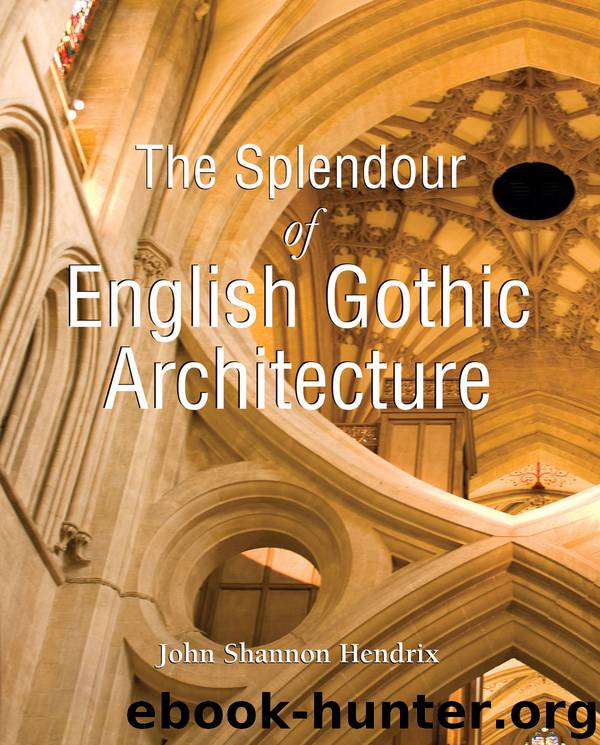The Splendor of English Gothic Architecture by Hendrix John

Author:Hendrix, John. [Hendrix, John Shannon]
Language: eng
Format: epub
ISBN: 9781783107940
Publisher: Parkstone International
Nave, vault replaced after 1840. York Minster.
West front. Exeter Cathedral.
Chapter house vault, c. 1300. Southwell Minster.
The design of Exeter Cathedral is consistent from its conception in around 1275 to its completion one hundred years later. The design can be seen as the apotheosis of the Early Decorated style of the second half of the 13th century, as found in particular in the Angel Choir at Lincoln, and the east end of Westminster Abbey, the two main sources of the design at Exeter. It is possible that the masons at Exeter worked in Lincoln and London.
The architecture of Exeter Cathedral takes the emphasis on surface pattern at Lincoln to the extreme. No new style or vocabulary elements are invented at Exeter, no liernes or Curvilinear tracery; the existing style is just pushed to its limits, with more tiercerons in the vaults (eleven per bay, as opposed to seven at Lincoln), and more shafts on the piers, more membrification, and more naturalism in the geometrical architectural forms.
The chapter house at Southwell Minster dates from the end of the Early Decorated period, around 1290. The arcade (Illustration 1, 2), executed under Archbishop John de la Romaine, consists of thirty-six stalls, five per side of the octagonal plan, minus four, with shafts with foliate capitals supporting narrow trefoil arches which are surmounted by crocketed triangular gables, with their tips at a cornice line. The crockets recall the “burning bushes” of the York chapter house.
Interspersed in the blind arcade are a variety of foliate sculptures, including leaves and foliage (the “leaves of Southwell” celebrated by Nikolaus Pevsner), animals, beasts, and faces of the pagan Green Men, with leaves growing out of them. The leaves, realistically represented, include maple, oak, hawthorn, ranunculus, potentilla, vine, and ivy.
Though realistically represented, the leaves are not imitated precisely, as concessions are given to the quality of the stone being carved, so that the leaves are somewhat manneristic, and express a synthesis of nature and the human mind, in a representation of the leaves as filtered through an aesthetic perception of them. The carvings were never painted. The stone is a fine-grained magnesian limestone quarried near Mansfield, fifteen miles away.
As Pevsner put it poetically in the Leaves of Southwell, “the balance of Southwell” is “something deeper too than a balance of nature and style or of the imitative and decorative” (quoted in Pevsner and Metcalf, 309), mimesis and abstraction. It is “perhaps also a balance of God and the world, the invisible and the visible”, spirit and matter, the same balance represented in the geometries of the architecture. The carved leaves can be experienced on a variety of levels: visually, sensually, emotionally, and intellectually. “The inexhaustible delight in live form that can be touched with worshipping fingers and felt with all senses is ennobled … by the conviction that so much beauty can exist only because God is in every man and beast, in every herb and stone.”
The presence of the divine in nature reinforces the presence of the divine in
Download
This site does not store any files on its server. We only index and link to content provided by other sites. Please contact the content providers to delete copyright contents if any and email us, we'll remove relevant links or contents immediately.
Kathy Andrews Collection by Kathy Andrews(10605)
The remains of the day by Kazuo Ishiguro(7612)
Spare by Prince Harry The Duke of Sussex(4254)
Paper Towns by Green John(4203)
The Body: A Guide for Occupants by Bill Bryson(3874)
Be in a Treehouse by Pete Nelson(3255)
Harry Potter and the Goblet Of Fire by J.K. Rowling(3136)
Goodbye Paradise(3014)
Never by Ken Follett(2950)
Into Thin Air by Jon Krakauer(2732)
The Remains of the Day by Kazuo Ishiguro(2643)
The Genius of Japanese Carpentry by Azby Brown(2635)
The Cellar by Natasha Preston(2627)
Drawing Shortcuts: Developing Quick Drawing Skills Using Today's Technology by Leggitt Jim(2551)
120 Days of Sodom by Marquis de Sade(2467)
Architecture 101 by Nicole Bridge(2373)
Machine Learning at Scale with H2O by Gregory Keys | David Whiting(2362)
The Man Who Died Twice by Richard Osman(2339)
Industrial Automation from Scratch: A hands-on guide to using sensors, actuators, PLCs, HMIs, and SCADA to automate industrial processes by Olushola Akande(2285)
